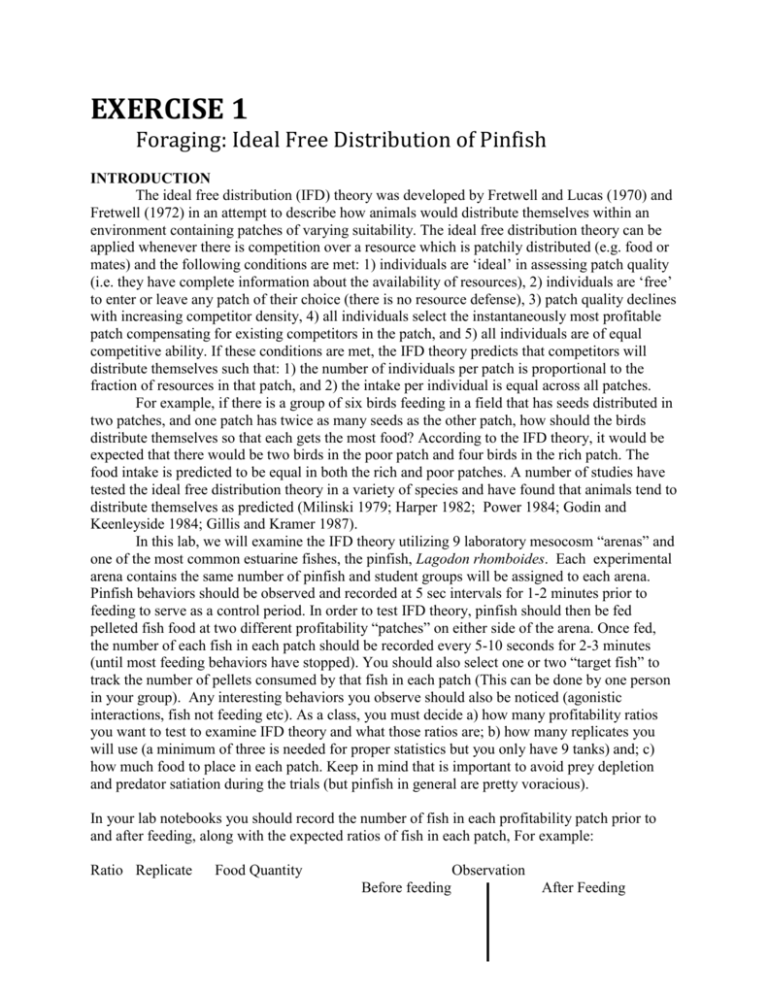Lab EXERCISE 1
advertisement

EXERCISE 1 Foraging: Ideal Free Distribution of Pinfish INTRODUCTION The ideal free distribution (IFD) theory was developed by Fretwell and Lucas (1970) and Fretwell (1972) in an attempt to describe how animals would distribute themselves within an environment containing patches of varying suitability. The ideal free distribution theory can be applied whenever there is competition over a resource which is patchily distributed (e.g. food or mates) and the following conditions are met: 1) individuals are ‘ideal’ in assessing patch quality (i.e. they have complete information about the availability of resources), 2) individuals are ‘free’ to enter or leave any patch of their choice (there is no resource defense), 3) patch quality declines with increasing competitor density, 4) all individuals select the instantaneously most profitable patch compensating for existing competitors in the patch, and 5) all individuals are of equal competitive ability. If these conditions are met, the IFD theory predicts that competitors will distribute themselves such that: 1) the number of individuals per patch is proportional to the fraction of resources in that patch, and 2) the intake per individual is equal across all patches. For example, if there is a group of six birds feeding in a field that has seeds distributed in two patches, and one patch has twice as many seeds as the other patch, how should the birds distribute themselves so that each gets the most food? According to the IFD theory, it would be expected that there would be two birds in the poor patch and four birds in the rich patch. The food intake is predicted to be equal in both the rich and poor patches. A number of studies have tested the ideal free distribution theory in a variety of species and have found that animals tend to distribute themselves as predicted (Milinski 1979; Harper 1982; Power 1984; Godin and Keenleyside 1984; Gillis and Kramer 1987). In this lab, we will examine the IFD theory utilizing 9 laboratory mesocosm “arenas” and one of the most common estuarine fishes, the pinfish, Lagodon rhomboides. Each experimental arena contains the same number of pinfish and student groups will be assigned to each arena. Pinfish behaviors should be observed and recorded at 5 sec intervals for 1-2 minutes prior to feeding to serve as a control period. In order to test IFD theory, pinfish should then be fed pelleted fish food at two different profitability “patches” on either side of the arena. Once fed, the number of each fish in each patch should be recorded every 5-10 seconds for 2-3 minutes (until most feeding behaviors have stopped). You should also select one or two “target fish” to track the number of pellets consumed by that fish in each patch (This can be done by one person in your group). Any interesting behaviors you observe should also be noticed (agonistic interactions, fish not feeding etc). As a class, you must decide a) how many profitability ratios you want to test to examine IFD theory and what those ratios are; b) how many replicates you will use (a minimum of three is needed for proper statistics but you only have 9 tanks) and; c) how much food to place in each patch. Keep in mind that is important to avoid prey depletion and predator satiation during the trials (but pinfish in general are pretty voracious). In your lab notebooks you should record the number of fish in each profitability patch prior to and after feeding, along with the expected ratios of fish in each patch, For example: Ratio Replicate Food Quantity Observation Before feeding After Feeding 2:1 2:1 1 1 20 10 20s 40s 2 4 3 3 60s 20s 40s 60s 2 4 4 2 4 2 3 3 All data should be entered into a shared class document. You should plot the average number of fish in each patch over time (before and after feeding) for each ratio (This may be done as a class depending on time). Determine the expected number of fish in each patch according to IFD theory. Examine the data visually. Based on the graphs, in your lab notebooks, answer the following questions: 1) Did fish seem to be evenly distributed before feeding? 2) How did fish distributions change after feeding? 3) Is there any evidence of satiation? Why? 4) Does it look like fish distribution conformed to IFD theory? 5) What statistics do you think you could you use to determine this? Answer the following questions in a separate word document and email it to me by 9am Friday. 1) Did the fish distribute themselves according to IFD theory for each ratio? 2) If not what explanations do you think might account for the differences? 3) Did all pinfish appear to have the same competitive ability? What behaviors did you observe that led to this conclusion? 4) Do you believe the assumptions of IDF theory are relevant to natural scenarios? Why or why not? 5) What other aspects of animals or their interactions do you think should be added to IFD theory to explain animal distributions?





![Pumpkin Patch - L2 exam summary questions[1]](http://s3.studylib.net/store/data/006891404_1-eaba8a01ed43ce8c58f5173adc5f257b-300x300.png)



